| dc.contributor.author | Olsø, Brynhild Garberg | |
| dc.contributor.author | Haukø, Anne-Marit | |
| dc.contributor.author | Risholt, Birgit Dagrun | |
| dc.date.accessioned | 2024-02-29T07:31:38Z | |
| dc.date.available | 2024-02-29T07:31:38Z | |
| dc.date.created | 2024-02-22T10:11:24Z | |
| dc.date.issued | 2024 | |
| dc.identifier.issn | 2405-8440 | |
| dc.identifier.uri | https://hdl.handle.net/11250/3120377 | |
| dc.description.abstract | Insulation products made of expanded polystyrene (EPS) are commonly utilized in buildings. However, Norwegian building regulations restrict the use of such combustible insulation due to an increased risk of fire spread and generation of smoke and toxic gases. Installation of fire protection coverings has been adopted as a mitigation strategy to address these safety risks. Notably, the current regulations lack pre-approved solutions describing what is considered an adequate protection of combustible insulation. The present study investigated the fire protection properties of selected coverings used to protect EPS insulation in inner walls. Eight comparative fire tests were conducted using an indicative fire resistance test furnace. The test specimens consisted of EPS blocks mounted on a wooden frame and covered with one or two layers of selected board coverings. The specimens were positioned vertically within the test furnace, and each fire test lasted for 10 or 15 min. Test results revealed that only two configurations consisting of either two layers of 12.5 mm gypsum boards or a combination of 12 mm oriented strand board (OSB) and 12.5 mm gypsum board showed no evidence of damage to the EPS substrate after a 15-min fire exposure. Consequently, the findings suggest that a total covering thickness of at least 24.5 mm, comprising two layers of boards, is necessary to prevent adverse effects on EPS insulation. Furthermore, fire tests conducted on coverings with introduced damages and defects showed that the affected area around the damages and defects were limited. For the standard EPS substrate, this area extended from 28 mm to 90 mm, while for the fire-retardant EPS substrate from 28 mm to 75 mm after a 10-min fire exposure. These results suggest that minor physical failures in the covering have limited impact on the fire safety of the system. | en_US |
| dc.language.iso | eng | en_US |
| dc.rights | Attribution-NonCommercial-NoDerivatives 4.0 Internasjonal | * |
| dc.rights.uri | http://creativecommons.org/licenses/by-nc-nd/4.0/deed.no | * |
| dc.subject | Fire testing | en_US |
| dc.subject | Fire protective covering | en_US |
| dc.subject | Combustible insulation | en_US |
| dc.subject | Fire safety | en_US |
| dc.subject | Expanded polystyrene | en_US |
| dc.subject | EPS | en_US |
| dc.subject | Fire protection engineering | en_US |
| dc.title | Experimental study of fire exposed expanded polystyrene (EPS) insulation protected by selected coverings | en_US |
| dc.type | Peer reviewed | en_US |
| dc.type | Journal article | en_US |
| dc.description.version | publishedVersion | en_US |
| dc.rights.holder | © 2024 The Authors. | en_US |
| dc.source.volume | 10 | en_US |
| dc.source.journal | Heliyon | en_US |
| dc.identifier.doi | 10.1016/j.heliyon.2024.e26309 | |
| dc.identifier.cristin | 2248731 | |
| dc.relation.project | Norges forskningsråd: 309380 | en_US |
| dc.source.articlenumber | e26309 | en_US |
| cristin.ispublished | true | |
| cristin.fulltext | original | |
| cristin.qualitycode | 1 | |

